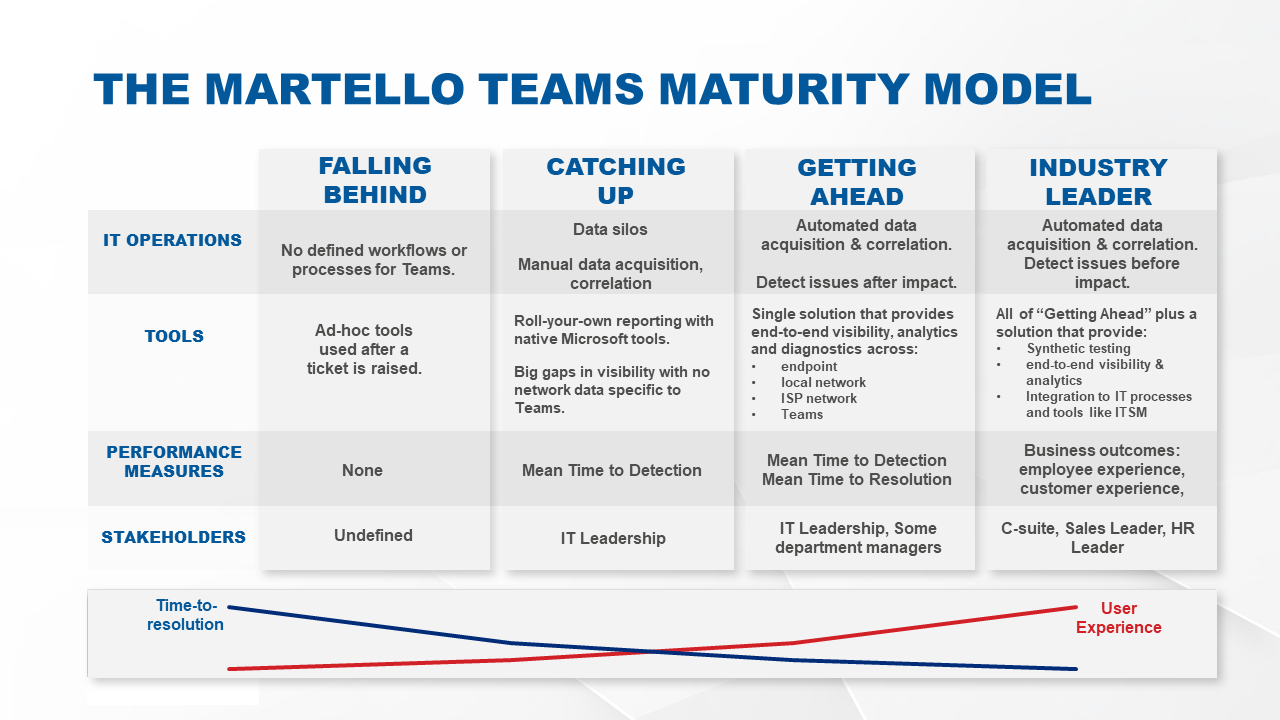Why Microsoft Teams ‘Maturity’ Matters
Microsoft Teams Monitoring
Maturity models have proved to be powerful tools for assessing performance and driving improvement in a wide range of industries and disciplines from cybersecurity and quality control to project management and HR. With hybrid and remote work here to stay, organizations now have a new kind of maturity to aspire to, one that has a significant and direct impact on business results: virtual collaboration maturity.
According to a January 2024 article in Forbes, hybrid work accounted for nearly 30% of all work arrangements in 2023. Full-time work-from-home totalled a further 12.7%. That means just under half of all workers last year required some form of virtual collaboration capability to stay connected and productive. It’s fair to assume Microsoft Teams would have been the dominant tool of choice, as it’s relied on by more than a million organizations and 320 million users worldwide.
So how well are organizations managing their Microsoft Teams performance and user experience? What’s their “Microsoft Teams maturity”?
Rose-colored glasses
A poorly managed Teams experience can hit an organization hard, especially as usage scales up. In a business with 5,000 employees, even a three percent call failure rate can add up to a whopping 3,450 calls and 172 hours of lost productivity. When IT support is factored in, the price tag can be upwards of $500,000. Every year.

Understanding those stakes drove Martello to develop a maturity model for organizations that use Microsoft Teams. The model has four stages: Falling Behind, Catching Up, Getting Ahead and Industry Leader. To test it, we surveyed 200 U.S.-based organizations in the winter of 2024.
The results were downright startling.
The vast majority (85%) of IT leaders said they thought their organizations had a “very good” or “excellent” ability to manage Microsoft Teams. Yet measured against the criteria of the model, an astounding 95% of organizations are actually Falling Behind or Catching Up — ranking in the bottom two tiers.
While this seems like a major disconnect, other findings suggest most organizations have an inkling that things could be better, with nearly all — 92% — saying it was important to improve their Teams performance. Just under 20% went so far as to say it was urgent to do so.
Where most organizations fall short
The markers of Microsoft Teams maturity are well-defined IT practices, integrated end-to-end tools, clear performance measures and awareness of key stakeholders — who Teams performance matters to and why. Most organizations land in the bottom two buckets because they lack good process, automated solutions and visibility across the whole Teams IT environment.
The visibility deficit is especially key because it leaves IT teams dependent on user reports to know when Microsoft Teams issues are occurring, and research shows users rarely open tickets when they have trouble.
In addition to good processes, automation and visibility, Industry Leaders also tend to seek as much meaningful and up-to-date performance data as they can get and have measures and internal accountabilities to ensure the needs of the business are being met.
How to build Microsoft Teams maturity
Organizations that find themselves Falling Behind or just Catching Up shouldn’t despair. The maturity model lays out a path to advance and gain control over the Microsoft Teams experience.
A first important step is to gather baseline data. Looking at the Microsoft Call Quality Dashboard will give a sense of how many poor and failed calls the organization is experiencing. Since this is a fairly blunt measure without much segmentation, the next task is to identify and prioritize which user segments are most affected by poor call quality. These will vary by organization and may be geographical, departmental or determined by user importance — who counts as a “business VIP”. Segmenting this way helps focus troubleshooting efforts when issues arise.
Since most Teams issues originate in the corporate network, it’s a good idea to dedicate time and attention to beefing up monitoring capabilities there first. But building toward an end-to-end view is crucial: one that gives a window not only into the Microsoft data center but also the connecting service provider and enterprise networks and right down to individual endpoints and conferencing equipment.
In addition to its maturity model, Martello has the technology to help organizations gain ground quickly in managing Microsoft Teams performance and the user experience. Our Vantage DX solution converts what would otherwise be cumbersome manual processes into streamlined, automated ones.
Watch for further posts in the weeks ahead and download our Microsoft Teams Maturity Model report for insight into how to get more from your Teams investment.
If you are ready to take the steps to improve book a quick call with us today and we can help.


